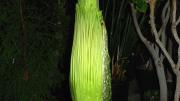A rare titan arum (Amorphophallus titanum), housed in the greenhouse used by Harvard’s department of organismic and evolutionary biology, is set to bloom in the next few days, resulting in a flower possibly six feet tall. The Indonesian rainforest species is sometimes known as the carrion flower or "corpse plant," due to its fetid odor, which resembles that of decomposing meat. Although in full bloom it appears as an enormous flower, it is actually an inflorescence of hundreds of tiny flowers hidden behind a huge, petal-like structure at the base of an enormous stalk. The inflorescence lasts only a few days, after which it collapses; it can take up to five years before the plant flowers again. Indigenous only to the rainforests of Sumatra, the titan arum is cultivated in botanic gardens across the world. In July 2008, one of the species flowered at Smith College.
Although the greenhouse is not open to the public, Doug Goldman, the Harvard University Herbaria associate who brought the story to the magazine's attention, will be providing updated photos in the days to come.


















